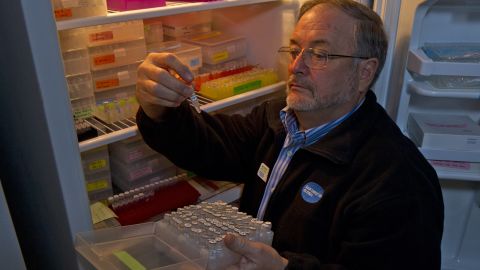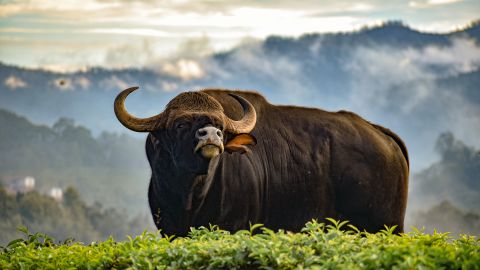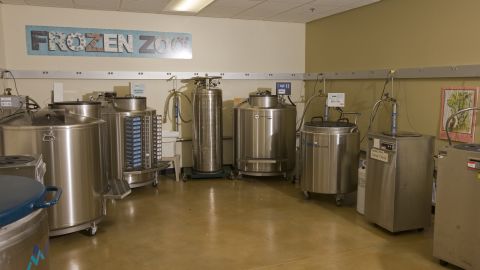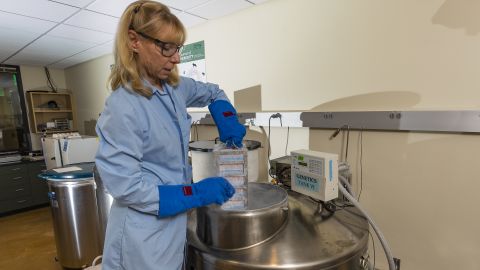When Kurt Benirschke started collecting skin samples from rare and endangered animals in 1972, he didn’t have a firm plan on what to do with them. As a researcher at the University of California San Diego, he believed that one day the tools would be developed to use them to save those animals. A few years later, he moved his collection to San Diego Zoo, and called it the Frozen Zoo.
n 2003, the banteng, a species of wild cattle found in Southeast Asia, became the second endangered species to be cloned. The procedure used cells from the Frozen Zoo, and the male, named Jahava, survived for seven years at San Diego Zoo.
“Famously, there was a poster that hung above the Frozen Zoo with a quote that said, ‘You must collect things for reasons you don’t yet understand,’” says Oliver Ryder, a geneticist at San Diego Zoo and an early collaborator with Benirschke. “We felt that we were stewards of this growing collection that was going to have value to the future in ways we weren’t able to appreciate then.”
Benirschke passed away in 2018, but his efforts are very much alive. Today, the Frozen Zoo is the world’s largest animal cryobank, with samples from over 10,500 individual animals from 1,220 species.
For a long time, it was the only project of its kind; in recent years, however, similar conservation efforts have sprouted around the world, and the tools that Benirschke didn’t yet have are now available. At the same time, the clock is ticking for many species at risk.

‘An irreplaceable repository of very rare animals’
Since 1970, populations of mammals, birds, amphibians, reptiles and fish have fallen by 68% on average, according to the WWF Living Planet Report 2020. The report also states that as a result of loss of habitat due to human activities, one million species – animals and plants – are threatened with extinction over the coming decades and centuries.
With the current rate of biodiversity loss, some scientists believe preserving samples from species that might not be here tomorrow is no longer a visionary endeavor, but a scientific must-do.
“As the effort built up, we realized that we were collecting an irreplaceable repository of very rare animals,” says Ryder. “Because we have cells in the Frozen Zoo, we can now apply new techniques and new technologies to extend our understanding, and learn more information that’s of direct relevance to preventing extinction in endangered species.”
The black-footed ferret was thought to be extinct in the wild until a small population was rediscovered in Wyoming in 1981 -- but it was decimated by disease. A clone named Elizabeth Ann was born in 2020 thanks to the genetic material of a ferret that had been kept in storage at the Frozen Zoo since 1988, the first time a native endangered species had been cloned in the US. It's hoped that cloning can help restore genetic variation into the surviving population.
Since the Frozen Zoo was founded, Ryder says, many milestones have been reached in the field of genetics, starting with the cloning of the first animal – a sheep named Dolly – in 1996. Starting in 2001, four endangered species have been cloned using genetic material from the Frozen Zoo: the Indian Gaur, a humpbacked Asian wild ox; the Banteng, a Southeast-Asian species of cattle; Przewalski’s horse, once found throughout Mongolia and extinct in the wild until recently; and the Black-footed ferret, which was believed to be extinct in the wild until it resurfaced in 1981, but was then almost wiped out by an epidemic.

Genetic rescue
Although cloning isn’t perfect – the cloned Indian Gaur only survived for 48 hours – it’s a useful tool to help save endangered species, because it can increase genetic diversity. When the population of a species dwindles, the remaining animals are forced to inbreed and the genetic pool shrinks, further threatening survival. But the cloned Black-footed ferrets, for example, were born in 2020 from samples collected in 1988, which meant that their genetic profile was much more varied than the current population.
“In a species of animals, the genetic diversity is what gives it its resilience, its ability to bounce back from natural catastrophes, virus attacks, disease attacks. That’s because if there are more different types of genetics in a species, there is a higher chance that some will survive,” explains Brendon Noble, a professor of regenerative medicine at the University of Westminster in London and chair of the board at The Frozen Ark, a UK-based animal cryobank.
The Frozen Ark was founded in 2004, with a similar intent to the Frozen Zoo but with a different structure: rather than a single collection tied to one institution, it is a distributed network of over two dozen institutions such as zoos, museums and universities spread all over the world, each sharing its own collection and knowledge.
While the Frozen Ark has more samples than the Frozen Zoo – 48,000 from 5,500 species – about 90% of them are made up of DNA rather than live cells, which are used differently and must be stored at much lower temperatures.
DNA samples can’t be used to clone an animal but are essential to capture the genetic blueprint of species that might disappear. “That information can be used for a whole range of different scientific studies, from cancer research to understanding recovery processes such as limb regrowth,” says Lisa Yon, an associate professor of zoo and wildlife medicine at the University of Nottingham and a scientific advisor at the Frozen Ark. “By saving these resources we will allow not only current scientists, but future generations of scientists to make all kinds of new discoveries.”

A cell by any other name
Freezing cells involves a more delicate process than with DNA, to avoid the formation of ice crystals when cells are frozen to -320 degrees Fahrenheit (-196 Celsius). Different cells require different freezing procedures, too; for example, amphibian cells are difficult to freeze properly and therefore are severely underrepresented in cryobanks. And some of the technologies that would make the best use of cell lines still need to be perfected.
Related story: ‘If we can make a space station fly, we can save the planet’
“A lot of stuff that we want to do we can’t do yet,” says Tullis Matson of Nature’s Safe, a UK-based cryobank that collects live cells and gametes (sperm and eggs). He predicts that in the next 10 to 30 years it will be possible to turn these cells into pluripotent stem cells, which can be reprogrammed to produce sperm and eggs.
Once that’s possible, an embryo could be created from the sperm and egg, and then implanted in a surrogate individual from an endangered species, once again providing much needed genetic diversity.

The technique also opens up the prospect of reviving fully extinct species – by using surrogates from the most genetically similar surviving animals. “We do have cells preserved from extinct species, but that’s not really the reason we do this,” says Ryder. “We’ve been asked to preserve cells from some of the last individuals in a species – or literally the last individual – and we do that, but we don’t really expect that we’re going to be able to bring species back from extinction from a single animal.”
The challenges ahead
The accelerating climate crisis will put ecosystems under further pressure, making the work of cryobanks even more important. “I see cryopreservation as the absolute cornerstone of conservation. We’re facing the sixth mass extinction as we speak, and we need to be able to give future generations a way of bringing these species back to life,” says Matson.
Many of the problems facing these projects are of a practical nature. “Safeguarding the Frozen Zoo far into the future is one of the biggest challenges,” says Frozen Zoo curator Marlys Houck. “We want to continue to collect more samples while ensuring that the ones we already have will be there beyond our lifetime. This includes making sure there is dedicated funding for liquid nitrogen [for freezing DNA] and replacement of the cryotanks as they age.”

One of the main challenges will be convincing conservation agencies that cryobanking is a valid strategy and worth funding. “Many of us are doing this without any tangible support beyond donations or grants, with no national or government support,” says Yon. “Cryobanking is increasingly being recognized as a vital resource, so it’s a bit mystifying that there isn’t more funding support.”
Finally, all researchers agree that a tighter collaboration between all cryobanks is necessary to succeed. “The task is enormous, nobody can do this on their own,” says Matson. “There’s a million species at risk. We need 50 different genetic samples from each, so that means 50 million samples; for each of those, we need five vials for each sample, so that’s hundreds of millions of samples that need to be stored.”
Ryder says he’s working to develop a global network to bank the material that’s already been collected.
“If we had a conversation with the future, they would say, please save as much biodiversity as you can, now. Period,” he adds. “And they would say, do that by all means available.”



Comments
Post a Comment